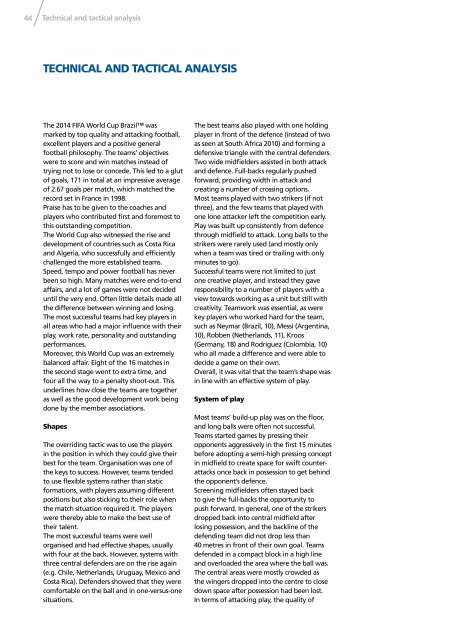2014fwc_tsg_report_15082014_neutral
2014fwc_tsg_report_15082014_neutral
2014fwc_tsg_report_15082014_neutral
You also want an ePaper? Increase the reach of your titles
YUMPU automatically turns print PDFs into web optimized ePapers that Google loves.
44<br />
Technical and tactical analysis<br />
TECHNICAL AND TACTICAL ANALYSIS<br />
The 2014 FIFA World Cup Brazil was<br />
marked by top quality and attacking football,<br />
excellent players and a positive general<br />
football philosophy. The teams’ objectives<br />
were to score and win matches instead of<br />
trying not to lose or concede. This led to a glut<br />
of goals, 171 in total at an impressive average<br />
of 2.67 goals per match, which matched the<br />
record set in France in 1998.<br />
Praise has to be given to the coaches and<br />
players who contributed first and foremost to<br />
this outstanding competition.<br />
The World Cup also witnessed the rise and<br />
development of countries such as Costa Rica<br />
and Algeria, who successfully and efficiently<br />
challenged the more established teams.<br />
Speed, tempo and power football has never<br />
been so high. Many matches were end-to-end<br />
affairs, and a lot of games were not decided<br />
until the very end. Often little details made all<br />
the difference between winning and losing.<br />
The most successful teams had key players in<br />
all areas who had a major influence with their<br />
play, work rate, personality and outstanding<br />
performances.<br />
Moreover, this World Cup was an extremely<br />
balanced affair. Eight of the 16 matches in<br />
the second stage went to extra time, and<br />
four all the way to a penalty shoot-out. This<br />
underlines how close the teams are together<br />
as well as the good development work being<br />
done by the member associations.<br />
Shapes<br />
The overriding tactic was to use the players<br />
in the position in which they could give their<br />
best for the team. Organisation was one of<br />
the keys to success. However, teams tended<br />
to use flexible systems rather than static<br />
formations, with players assuming different<br />
positions but also sticking to their role when<br />
the match situation required it. The players<br />
were thereby able to make the best use of<br />
their talent.<br />
The most successful teams were well<br />
organised and had effective shapes, usually<br />
with four at the back. However, systems with<br />
three central defenders are on the rise again<br />
(e.g. Chile, Netherlands, Uruguay, Mexico and<br />
Costa Rica). Defenders showed that they were<br />
comfortable on the ball and in one-versus-one<br />
situations.<br />
The best teams also played with one holding<br />
player in front of the defence (instead of two<br />
as seen at South Africa 2010) and forming a<br />
defensive triangle with the central defenders.<br />
Two wide midfielders assisted in both attack<br />
and defence. Full-backs regularly pushed<br />
forward, providing width in attack and<br />
creating a number of crossing options.<br />
Most teams played with two strikers (if not<br />
three), and the few teams that played with<br />
one lone attacker left the competition early.<br />
Play was built up consistently from defence<br />
through midfield to attack. Long balls to the<br />
strikers were rarely used (and mostly only<br />
when a team was tired or trailing with only<br />
minutes to go).<br />
Successful teams were not limited to just<br />
one creative player, and instead they gave<br />
responsibility to a number of players with a<br />
view towards working as a unit but still with<br />
creativity. Teamwork was essential, as were<br />
key players who worked hard for the team,<br />
such as Neymar (Brazil, 10), Messi (Argentina,<br />
10), Robben (Netherlands, 11), Kroos<br />
(Germany, 18) and Rodríguez (Colombia, 10)<br />
who all made a difference and were able to<br />
decide a game on their own.<br />
Overall, it was vital that the team’s shape was<br />
in line with an effective system of play.<br />
System of play<br />
Most teams’ build-up play was on the floor,<br />
and long balls were often not successful.<br />
Teams started games by pressing their<br />
opponents aggressively in the first 15 minutes<br />
before adopting a semi-high pressing concept<br />
in midfield to create space for swift counterattacks<br />
once back in possession to get behind<br />
the opponent’s defence.<br />
Screening midfielders often stayed back<br />
to give the full-backs the opportunity to<br />
push forward. In general, one of the strikers<br />
dropped back into central midfield after<br />
losing possession, and the backline of the<br />
defending team did not drop less than<br />
40 metres in front of their own goal. Teams<br />
defended in a compact block in a high line<br />
and overloaded the area where the ball was.<br />
The central areas were mostly crowded as<br />
the wingers dropped into the centre to close<br />
down space after possession had been lost.<br />
In terms of attacking play, the quality of


